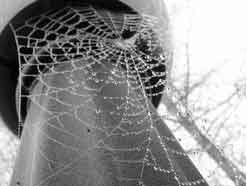By Douglas E. Cowen
 Many modern Pagans are fond of saying how overrepresented their numbers were among early computer programmers and builders. On the edge of this exciting new knowledge frontier, technopagans (think Jenny Calender on "Buffy the Vampire Slayer") seemed to work magic in the infinitesimal spaces between circuit pathways, carefully recording their rites in the arcana of machine language and command code.
Many modern Pagans are fond of saying how overrepresented their numbers were among early computer programmers and builders. On the edge of this exciting new knowledge frontier, technopagans (think Jenny Calender on "Buffy the Vampire Slayer") seemed to work magic in the infinitesimal spaces between circuit pathways, carefully recording their rites in the arcana of machine language and command code.
Of course, computer programming isn't magic -- but it's fun to think that it could be - and now computer engineering is one of the most popular faculties on campus -- with modern Pagans counting only a tiny fraction of those enrolled. The world of high tech has changed. In less than two decades -- from the creation of the World Wide Web and the ready availability of Web browsers -- the Internet has gone from a technological curiosity to part of the furniture for hundreds of millions of people. And, although in the mid-1990s many of us were dazzled by its possibilities, for young adults today the Web is no more remarkable than the telephone.
This is not to say, however, that Pagans have stopped weaving their webs online. Quite the contrary. As I was drafting this paragraph one of my friends invited me to join a Facebook group promoting a local Earth Spirit festival, while on Flickr, currently the most popular image sharing site in the world, hundreds of Pagans regularly post their artwork, photos of hand-crafted working tools, and pictures of ritual sites and celebrations. Indeed, Witches, Wiccans, Druids, and Asatruar abound on the Internet, using it in a wide variety of ways. Information clearinghouses such as The Witches' Voice and myriad online supply stores provide everything from basic information on casting a circle to ready-made ritual kits available for next-day delivery.
Often separated by thousands of miles, tens of thousands of Pagans use the Internet daily to connect with each other. Most still do it through email, but many use a plethora of discussion forums, chatrooms, and social networking sites. Blogging is now standard on the Pagan Web and some, like the uber-blogger Jason Pitzl-Waters' Wild Hunt, include podcasts and Internet radio. Still others, like the Jaguarmoon Cybercoven, function as full-fledged online ritual groups - though virtual ritual is far less common than one might suppose.
Many modern Witches and Wiccans see computer technology itself as an integral component of their magickal working -- as indispensable to them now as chalice, athame, and cauldron. "Computers are like demigods in a box," write Patricia Telesco and Sirona Knight, adding that "this demigod has a quintessential servant: the Internet." Whether or not one's computer mouse "is akin to a magic wand," "cyber magick" is the wave of the future, or cyberspace is "the doorway to the astral plane," Paganism online remains endlessly fascinating.
Although the world is not nearly so "wired" as many Internet enthusiasts suppose and there is little evidence that offline relationships are in danger of being replaced by their online counterparts, the Web still provides a significant and relatively risk-free means for those interested in Paganism to explore its various pathways and try on its various masks. I suspect that this may be one of its most important roles. Many newcomers are relieved when they log onto a Wiccan or a Druid discussion group and find that they are not alone after all, that there are like-minded folk with whom they can exchange information, trade gossip and opinion, or simply share a sense of community. There are others from whom they can learn -- if only what to avoid. For many, these groups are the first step into a wider world of spiritual belief and practice. Some will remain online only, secure in the relative anonymity the Internet affords and conscious of their ability to disconnect at will. Others, hungry for the embodiment on which Pagan spirituality thrives, quickly tire of electronic communication and seek to extend their connections offline.
For all its alleged wonders and its real advantages, this brings us to what I consider the principal limitation of the Internet, at least as far as modern Pagans are concerned. In many, perhaps most of its forms, Paganism is an embodied spirituality; it lives and breathes in the bone and the skin of its practitioners. Drawing Down the Moon -- during which the spiritual energy of the Goddess is physically embodied in a coven's High Priestess -- and The Great Rite -- the sacred marriage, whether performed actually or "in token" -- are ritual acts of devotion that do not translate to the keyboard, the screen, and the soundcard. Or at least they do not translate well. Visualizing snow piled in drifts among the standing stones may cause online participants to shiver in their workstation chairs, but that hardly compares with the experience of trying to keep warm while celebrating the winter solstice knee-deep in that same snow.
Douglas E. Cowan is Professor of Religious Studies at Renison University College at the University of Waterloo. He is the author of numerous books, including Cyberhenge: Modern Pagans on the Internet (Routledge, 2005); Sacred Terror: Religion and Horror on the Silver Screen (Baylor, 2008); and Sacred Space: The Quest for Transcendence in Science Fiction Film and Television (Baylor, 2010).
8/18/2009 4:00:00 AM




